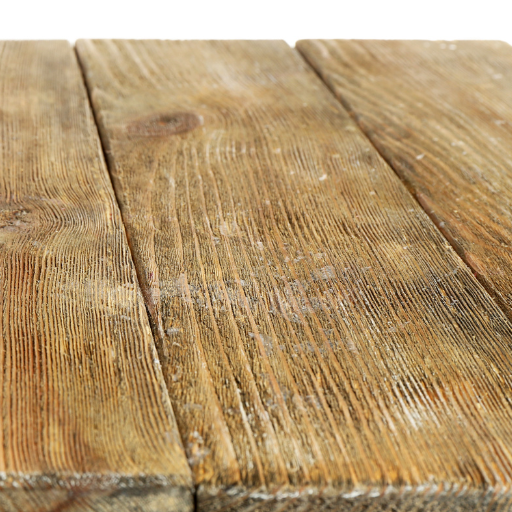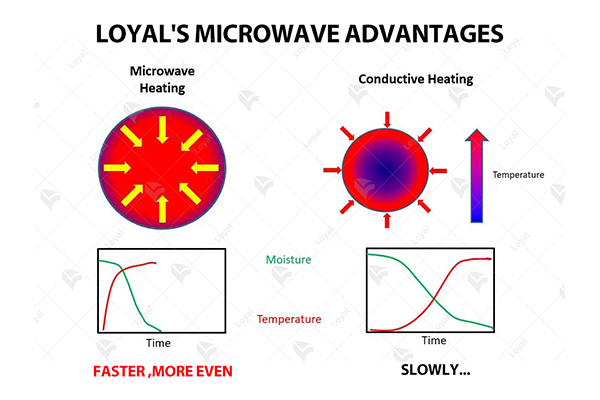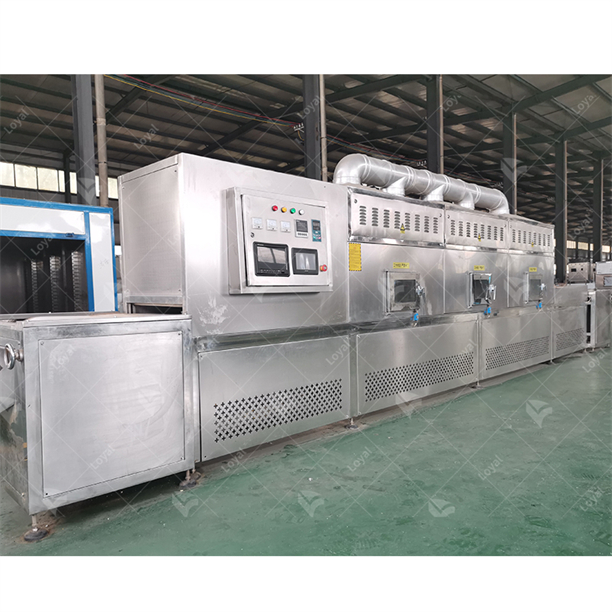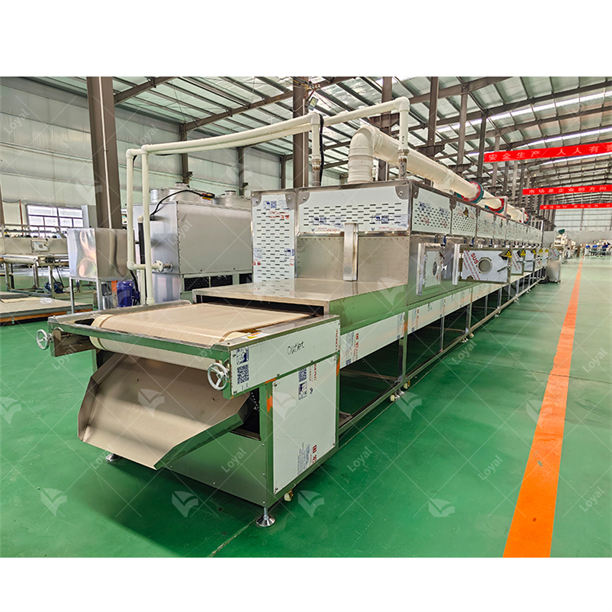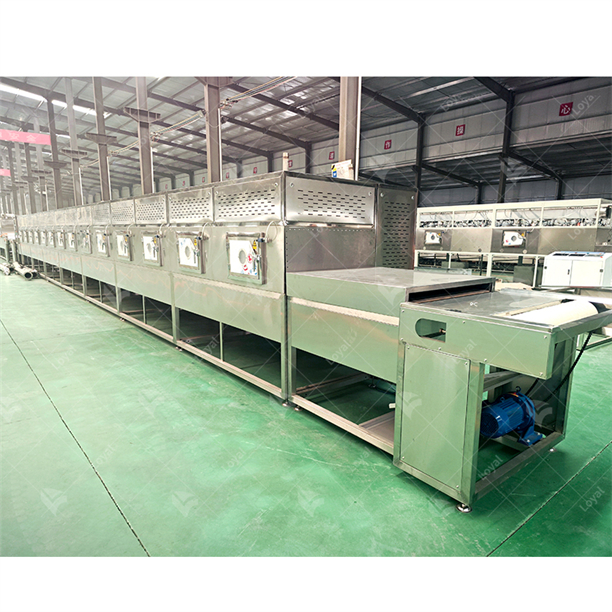The drying of wood is an essential thing that is done in the timber industry and influences the quality, durability, and application range of final products. The traditional methods used to dry wood, such as air drying or conventional kiln drying, present issues like long drying periods, non-uniform moisture content, and high energy consumption. These techniques may also occasion surface cracks while degrading the structural integrity of this material. In a rapidly changing landscape such as this one, Industrial Microwave Wood Drying Systems come to light with their improved efficiency, accuracy, and eco-friendliness, which are game-changing. This piece discusses the mechanisms behind microwave wood drying technology, its superiority over traditional methods, and possible implications for future concerns regarding this industry revolving around wood drying.
How Does Microwave Wood Drying Work?
The principle of microwave wood drying involves dielectric heating, where it oscillates rapidly with electromagnetic waves at the frequency range of microwaves through the wood; thus, polar molecules in the wood, mainly water. The generated thermal energy due to this oscillation is uniformly transmitted throughout the material, which causes moisture to start evaporating from the inside. To an extent, unlike other methods known for relying on surface heating and consequent conduction, microwave drying targets the water content deep within timber. This reduces drying time by far and ensures no cracks or internal stresses due to more even moisture distribution. Microwave drying requires precise & controlled application to tailor it for different species of wood & thicknesses.
Understanding Microwave Energy in Drying
Microwave energy in drying exploits dielectric properties of water whereby water molecules act as dipoles that align with alternating electric fields emitted by a microwave oven. Key technical parameters essential to understanding this process include: typically around 2.45 GHz for the frequency of microwaves and power level that can be adjusted depending on the specific needs of the wood being dried.
Crucial in determining how efficiently heat is transferred and subsequently how quickly heat is generated, SAR or Specific Absorption Rate is measured in watts per kilogram (W/kg) of wood. Additionally, one must consider how deeply microwaves penetrate into timber which depends upon its frequency and also factors such as whether it contains water or not since this will dictate if it has any dielectric constant. For instance, at 2.45 GHz, penetration depths into moist timber may vary from several cm to over ten centimeters depending on moisture levels and density.
Uniform heating obtained via microwave energy eliminates thermal gradients, thereby reducing chances for surface cracking or internal stress creation. The capacity to accurately control the amount of power released allows users to dry varying quantities according to their batch specifications resulting in optimum concentration phases.
The Role of Microwave Heating
Microwave heating works by interacting directly with water molecules inside the wood, which causes them to vibrate and generate heat from friction rapidly. This ensures that there is no temperature variance within the wood as it heats up. The key technical parameters for this process include.
- Microwave Frequency: The normal frequency used is 2.45 GHz. This frequency provides a good interaction with water molecules and balances heating efficiency and penetration depth.
- Power Level: Depending on wood thickness, density, and moisture content, power levels can be adjusted between several hundred watts to a few kilowatts.
- Specific Absorption Rate (SAR): Measured in watts per kilogram (W/kg), SAR plays a vital role in energy transfer efficiency assessment; thus regulating SAR prevents localized hotspots during consistent heating.
- Penetration Depth: At 2.45 GHz, penetration depths into moist timber typically range from a few centimeters to over ten centimeters, depending on moisture levels and timber density.
Considering the above parameters microwave heating leads to efficient removal of water without affecting the integrity of timber structure. Fine-tuning output power control specific absorption rate eliminates common problems experienced by traditional drying methods, such as uneven drying or surface cracks, which occur due to a lack of controlled environment in conventional ovens.
How does microwave drying compare to traditional methods?
There are several advantages of microwave drying when compared to the traditional wood drying methods such as air drying and kiln drying.
- Efficiency: Microwave drying greatly minimizes drying time. Whereas traditional methods may take weeks or even months, a microwave dryer can complete its task in a matter of hours. This makes the process highly productive and reduces storage expenses.
- Uniformity (Specific Absorption Rate and Power Level): Traditional techniques cause uneven drying, which results in internal stresses that lead to frequent cracking and warping. However, with microwaving, uniform heating can be attained by regulating the Specific Absorption Rate (SAR) and power levels. This results in uniform moisture removal from all parts of the timber due to even heat penetration.
- Lower Energy Consumption: Traditional kiln-drying methods require longer time under heat thus use vast amounts of energy. As such, microwave systems have higher energy efficiency because they can selectively heat moisture-rich wood quickly.
- Controlled Environment (Microwave Frequency): The microwave frequency used for this purpose is 2.45 GHz, which has been optimized for effective interaction with water molecules. In this way, we can obtain precise control over the parameters used during the drying process, unlike air drying, where no factors control it except for weather conditions.
- Quality of Wood (Penetration Depth): Microwave penetration depth ranges from a few centimeters up to more than ten centimeters depending on moisture content and density in wood, ensuring deep-seated moisture removal, thereby avoiding surface cracks so as not to compromise the integrity of the wood, hence high quality remains maintained.
By focusing on these technical parameters, one can clearly see that microwave drying surpasses other conventional techniques in terms of efficiency and quality
What Are the Benefits of Using a Microwave Drying System?
Microwave drying systems have numerous advantages. In the first place, drying takes place rapidly as compared to the traditional methods, facilitating faster throughput and processing. The other merit of this system is that it uses less energy by directing attention to moisture, hence reducing energy consumption. The third advantage is that it allows for uniform heating, preventing cracking and warping among other structural damages. Moreover, its accurate control of drying conditions results in consistent good quality product and minimizes supervision and modification of classical dryers. Lastly, microwave drying leads to increased durability of the final product thus retaining its physical and mechanical properties.
Fast Drying Results
For instance, microwave drying systems provide much faster drying results than conventional methods do (according to top Google). This attribute is because; microwaves transmit electromagnetic waves directly into water molecules with a lot of heat being generated internally thus speeding up moisture evaporation.
Some technical parameters are responsible for this trend in reduced period:
- Penetration Depth: Microwaves have penetration depths ranging from 2 cm up to over 10 cm, depending on the wood species’ density and moisture content, thereby ensuring fast withdrawal of moisture trapped deep inside.
- Dielectric Properties: Additionally, the effectiveness of microwave drying depends on its dielectric properties, which determine how much microwave energy is absorbed or converted into heat. Higher moisture-containing woods show better coupling to the microwaves, hence facilitating quicker drying.
- Frequency of Microwaves: Industrial microwave dryers work at 915 MHz or 2450 MHz frequencies which enable deep penetrating evenness in dying for surfaces thereby preventing ubiquitous cracks formation and internal stresses.
By using these technological features, besides making the process quicker, also ensures better quality end products with lower defects and improved structural strength.
Uniform Moisture Content
In addition, one more benefit associated with microwave drying technology is consistent moisture content due to homogeneity within material. Prior art techniques are often characterized by uneven wetness caused by external heat sources or varying airflow conditions. In contrast, microwave drying occurs within the material through electromagnetic wave penetration that uniformly heat up the materials. This minimizes the moisture gradient by internal heating causing uniform drying of entire material. It is also important to consider that such an approach considerably reduces overdrying and underdrying incidences which prevent cracking, splitting, warping and maintaining final product quality.
Efficiency and Energy Consumption
Microwave drying technology has higher efficiency and uses less energy than traditional drying techniques (Girard et al., 2006). The process takes longer because water molecules are heated directly instead of any other form. Some findings show that microwaves can save up to 50% energy thus eliminating long hours of heating required in conventional drying methods. Additionally, fewer reworks are necessary when microwave-dried due to its accuracy, leading to resource preservation. Furthermore, modernization in microwave technology has facilitated control power variations that suit different materials hence increases efficiency while reducing consumption of power.
What Challenges Exist in Industrial Microwave Wood Drying Systems?
There are many advantages of microwave wood drying systems, though it is still not easy for firms to adopt the technology. One of the main issues is initial capital investment for the microwave drying equipment, which is much higher than conventional systems. This can act as a hindrance against small-scale manufacturers who may not be able to afford the extra cost. Besides, controlling uniform heating of large-scale applications may be a challenge since lack of uniformity may cause localized overdrying or underdrying, affecting the quality of the timber. Furthermore, there should be an electromagnetic environment within the drying chamber that should be closely maintained so as to avoid interference and ensure worker safety. Finally, traditional industries might reject this technology due to its novelty and uncertain return on investment related to changing over traditional methods to microwave ones.
Initial Investment and Costs
Initially, investing in industrial microwave wood drying systems requires a substantial amount of money. In other words, this high upfront cost includes purchasing sophisticated tools and machinery, as well as installing and even modifying existing structures for accommodating new devices used in modern times. These costs are significantly higher compared to those associated with traditional methods but long-time savings on energy consumption and potential production efficiency improvements can compensate for the initial outlay. Microwave technology adoption may also qualify for different grants and incentives targeting the promotion of energy-efficient practices that are ecologically friendly. Consequently, while considering initial investment as important, overall financial benefits must therefore be judged in relation to the long-term.
Maintaining Temperature Control
Temperature control is crucial when operating industrial microwave wood drying systems to guarantee a uniform drying process without defects.The main objective here is maintaining continuous regulation of moisture content in wood through accurate adjustment of microwave power output.A feedback loop and sensor control system regulate power output depending on what happens inside the dry chamber.These parameters include acquisition abilities through integration of temperature alongside humidity sensors.
The technical parameters include microwave frequency, which normally ranges at around 915MHz or 2.45GHz, together with power levels, which can vary from a few kilowatts to several megawatts depending on the range of operation. Ensuring that microwave energy is distributed uniformly so as to maintain a uniform temperature is necessary. Additionally, management of air flow within the chamber will promote moisture elimination due to evaporation hence helping in sustaining constant drying atmosphere. Industrial microwave systems can, therefore, achieve high-quality drying with less possibility of defects by using these parameters and technologies.
Possibilities of Irregular Drying
Irregular drying in industrial microwave wood drying systems may be caused by numerous factors. To begin with, non-uniform distribution of microwave energy can lead to different degrees of moisture removal across wood areas. This irregularity could be worsened by natural variations in the properties of the wood such as different densities and grain patterns that dictate how microwave energy is absorbed and converted into heat. Second, wrong flow patterns inside the drying chamber could create some places where evaporated water accumulates thus interfering with proper drying and causing wet spots in localized areas. At last, unsatisfactory controlling devices which do not detect or rectify these disparities can result into non-uniform drying leading to warping and cracking. So, handling these problems involves optimizing the configuration of microwave energy scattering equipment, ensuring adequate air movement control within the drying space, and using up-to-date control systems for maintaining a uniform mode of dryness.
Can Microwave Drying Be Applied to All Types of Wood?
Microwave drying can be applied to any kind of wood depending on various factors such as wood species, moisture content and intended use. Information from reliable sources shows that microwave drying is generally applicable for most types of wood; although the efficiency differs. For instance, some hardwoods and those with high density variations may suffer uneven drying, resulting in incidences like cracking or splitting. Softwoods dry better under microwaves since they have a more uniform structure. Furthermore, pretreatment processes and accurate manipulation of drying parameters are vital for desired outcomes. In conclusion, even though microwave drying can be used for many kinds of woods, one has to consider its specific attributes as well as observe controlled drying protocols which will lead to consistent quality results. Length: approx 142
Different Wood Species and Their Reactions
- Oak: Oak is a dense hardwood with significant variation in grain structure and moisture content. Microwave drying of oak requires precise control to avoid internal stresses that can cause warping. Studies indicate that maintaining a uniform drying rate and gradually reducing moisture can minimize defects.
- Pine: Pine, a common softwood, generally responds well to microwave drying due to its relatively uniform cell structure. Data shows that pine can achieve consistent moisture reduction with minimal structural damage, making it suitable for construction and furniture.
- Maple: Maple is another hardwood, known for its fine grain and hardness. Microwave drying of maple must account for its tendency to crack under rapid moisture loss. Research suggests that a slower drying process can produce better results, although it extends the drying time.
- Cherry: Cherry wood is prized for its color and smooth grain but can be prone to cracking if dried too quickly. Effective microwave drying of cherry wood includes pre-treatment steps such as steaming to relax internal stresses and ensure an even moisture profile.
- Spruce: A softwood with applications in musical instruments and construction, spruce has a uniform grain that benefits from microwave drying. Data indicates that spruce can achieve rapid drying with minimal degradation in structural integrity, aiding in faster production cycles.
- Walnut: Walnut’s dense and irregular grain makes it challenging to dry it in microwaves. Controlled drying parameters need to be carefully managed to prevent surface checking and internal cracking. Empirical studies recommend a combined approach using conventional drying methods initially, followed by microwave drying for optimal results.
- Cedar: Cedar dries relatively easily due to its low density and aromatic resin content. Microwave drying of cedar is effective for maintaining its structural properties and natural resistance to decay. Test results show that cedar can quickly achieve consistent moisture levels, making it suitable for closet linings, outdoor furniture, and shingles.
In summary, while microwave drying is an efficient method for reducing moisture content in a variety of wood species, the process must be tailored to accommodate each type of wood’s unique properties and susceptibilities. Proper pre-treatment and controlled drying protocols are imperative for ensuring high-quality, defect-free results.
Special Considerations for Lumber and Wood Products
When considering microwave drying for lumber and wood products, several special considerations must be considered to ensure optimal results. These include moisture content, temperature control, wood thickness, and potential defects:
- Moisture Content: Initial moisture content varies significantly between different wood species. For optimal microwave drying, it’s important to establish the baseline moisture content to prevent uneven drying. For instance, wood with high initial moisture might require a stepped drying approach to avoid surface drying and internal moisture retention.
- Temperature Control: The drying temperature needs to be meticulously controlled to prevent thermal degradation. Technical data suggests maintaining temperatures below 100°C for most species to avoid wood fibers and resin exudation degradation. For example, spruce and cedar can tolerate relatively higher temperatures due to their low density and resin content, while walnut requires more cautious temperature management.
- Wood Thickness: The thickness of the wood significantly influences the drying time and efficiency. Thicker pieces require more time, potentially necessitating multiple drying cycles or a combination of conventional and microwave drying. For instance, empirical studies show that thicknesses above 50mm for walnut may benefit from an initial conventional drying phase to balance moisture distribution before introducing microwave energy.
- Potential Defects: Monitoring potential defects such as surface checking, internal cracking, and warping is crucial. Studies recommend continuous monitoring during the drying process through non-destructive testing methods like X-ray scanning or infrared thermography. This allows for real-time adjustments to drying parameters ensuring the structural integrity of the wood remains uncompromised.
- Technical Parameters: Specific parameters such as microwave power levels, drying time, and humidity control must be calibrated based on the wood’s species and its intended application. Research indicates that a power level of 2-5 kW is effective for softwoods like spruce. In contrast, hardwoods like walnut may require lower power levels and extended drying durations to mitigate internal stresses.
By precisely tuning these parameters, the microwave drying process can be optimized, enhancing efficiency while maintaining the quality of the lumber and wood products.
What Are the Latest Advancements in Microwave Wood Drying Technology?
Important aspects of the most recent microwave wood drying advancements have included a greater focus on energy efficiency with microwave generator designs that aim to minimize power consumption while maintaining high drying rates and the development of advanced magnetrons and solid-state microwave sources for more exact control over power output and distribution. Additionally, integration into advanced monitoring systems is becoming one significant trend. It offers continuous adjustment of drying parameters by using real-time data from moisture sensors, infrared cameras and other non-destructive testing methods thus helping in preventing defects as well as enhancing quality control. Lastly, hybrid drying technologies involving a combination of microwave and conventional methods are increasingly being adopted. They combine the rapid moisture reduction capabilities of microwave energy with uniform conditioning provided through conventional drying, hence giving a better and more consistent dried product. These developments all have in common aspiration towards improving the efficiency, quality, and sustainability of the wood drying process.
Innovations in Microwave Techniques
Microwave timber drying technology has been recently advanced with several new techniques geared towards process optimization. One innovation is variable frequency microwaves, which allow control of the depth of energy penetration in the object so that only the core heats up while surface remains cold. Pulse power technology has also emerged as a significant milestone in microwave heating for wood processing. It is delivered in short high intensity outbursts hence enhances drying efficiency while lessens chances of thermal runaway and damage to wood.
Moreover, integration of AI-driven control systems has made great leaps. These systems employ machine learning algorithms to analyze real-time data from moisture sensors and adjust drying parameters accordingly on an ongoing basis. They have been found to apprehend and correct deviations during the process hence ensuring uniform quality and energy conservation. The main technical parameters are:
- Frequency Range: 915 MHz and 2.45 GHz are commonly used frequencies in variable-frequency microwaves, as they balance penetration depth with energy absorption efficiency.
- Power Output: Advanced generators now operate with a power range of 1-100 kW, which can be adjusted in real-time for optimal drying.
- Pulse Duration: Pulse power systems commonly operate with pulse durations in the microsecond to millisecond range, optimizing energy delivery.
These innovations collectively enhance microwave wood drying technology’s efficiency, quality, and sustainability.
Integration with Traditional Drying Methods
Combining traditional drying methods and microwave drying technology brings several benefits by merging strengths from each side. Traditional kiln drying is effective though it often consumes much time and energy. Incorporation of microwave technology into the process can speed up initial moisture removal, thus significantly reducing the overall drying period. This hybrid technique takes advantage of the fast heating ability of microwaves to condition wood before using conventional means to obtain uniform final moisture content with few defects. Again, use of this method makes the entire drying process economical in terms of power requirement for the kiln, which reduces operational cost and environmental impact. As a result, these methods results in higher productivity and better control over quality as per modern day timber industries’ strict requirements.
How Can You Implement Microwave Drying Systems in Your Business?
Integrating microwave drying systems in your business involves a number of important steps. In order to effectively integrate the microwave technology, there is a need for an inclusive analysis of your current drying processes and requirements. This survey should include things such as types of woods you deal with, present drying infrastructure and moisture content target that you aim at achieving. Also vital is selection of suitable microwave drying equipment. When thinking about this issue take care of such factors as scale (in terms of power output), pulse duration or frequency range to ensure compatibility with yours specific requirement according to the production process scale. Additionally, training the staff on using and maintaining the new equipment will help them adapt easily and work efficiently.
Lastly, it would be prudent to monitor and improve during this process so that we can see where necessary corrections are needed, thus ensuring a consistent quality product.
Choosing the Right Microwave Dryer
Choosing an appropriate microwave dryer necessitates consideration of a variety of technical parameters that match with your particular needs. To start with evaluate the power rating of these machines. Higher power outputs normally offer enhanced rates of drying, but deploying more complicated control systems might probably be required. For small-to-medium operations, one may find typical values like 10-30 kW, while some industrial-sized ones could go up to 150 kW.
Pulse duration and frequency range are other crucial aspects to consider next.Standard microwave dryers operate on 2.45 GHz which covers most wood species well enough.The adjustable pulse durations usually vary between 0.1 to 10 seconds hence facilitating flexibility in terms of moisture levels’ adjustments in various wood species which may require different periods for getting dried properly.
Further still; think about efficiency and energy usage within the system.Modern day units have been able to achieve up to 70-80% energy efficiencies thereby reducing operations costs as well as promoting sustainability.Additionally, assess the extent at which system can integrate into existing framework for instance, other drying methods like a kiln.
Lastly, evaluate the control interface and data monitoring capabilities. Improved versions are normally equipped with features such as real-time observation and self-adjustment to maintain optimal drying conditions.Thus, an easy-to-use interface and proper data logging facilities significantly advance process control and quality assurance in your wood processing.
Installation and Maintenance Tips
If you want to carry out a seamless microwave wood dryer installation, you must follow several basic steps. Begin by choosing a well-ventilated location away from flammable materials. Then, place the microwave dryer on a level surface so that it does not shake during operation. Ensure that the power supply has three phases for big machines.
Maintenance on the other hand requires regular inspections. Check whether there is any damage or dirt accumulated within internal components such as magnetrons or waveguides. Dust must not collect on inside surfaces or vents because this would decrease the efficiency of the equipment and cause it to overheat.As such, the replacement of such parts as filters or gaskets should be done at recommended intervals according to manufacturers’ instructions.
In addition, the interface of the controller allows for monitoring system performance. Some power output parameters to be aware of would be pulse duration and frequency. For example, a decrease in power output can suggest that either maintenance or components replacement is required. To maintain drying efficiency and product quality, pulse duration should remain within a range of 0.1-10 seconds.
These installation and regular maintenance rules are very important because they enable me to increase the life span of my microwave wood dryer by ensuring better performance and productivity as well as cost effectiveness in my wood processing industry.
Frequently Asked Questions (FAQs)
Q: What is industrial microwave drying and how does it compare to traditional methods like drying rooms and convection ovens?
A: Industrial microwave drying involves using microwave technology to rapidly and evenly remove moisture from wood. Unlike traditional methods like drying rooms and convection ovens, microwave drying is quicker and energy-efficient, offering improved product quality.
Q: How does a vacuum microwave wood dryer work?
A: A vacuum microwave wood dryer combines vacuum technology with microwave heating to effectively dry wood at lower temperatures. This method preserves the wood’s integrity and reduces drying time, making it suitable for high-quality drying applications.
Q: What are the benefits of using microwave ovens for wood drying?
A: Microwave ovens used for wood drying offer uniform moisture removal and reduced drying times. They are also energy-efficient and can help to minimize the potential for defects like warping and cracking commonly associated with traditional drying methods.
Q: Are there specific types of wood that are better candidates for microwave treatment?
A: Most types of wood can benefit from microwave treatment. Hardwoods, softwoods, and engineered woods like LVL lumber are all suitable candidates for the microwave drying method.
Q: How does industrial microwave drying affect the adhesive used in bonding layers of wood together?
A: Industrial microwave drying can effectively set adhesives used in bonding layers of wood together. The precise control over temperature and moisture helps achieve optimal adhesive bonding, enhancing the overall quality of laminated wood products.
Q: What are the common applications for industrial microwave wood drying systems?
A: Industrial microwave wood drying systems are commonly used in various drying applications, including color drying and adhesive setting, as well as drying engineered wood products like LVL lumber.
Q: Can drying with industrial microwave dryers affect the color and quality of the wood?
A: Yes, drying with industrial microwave dryers can impact the wood’s color and quality positively. The controlled process can help maintain the wood’s natural color and prevent issues such as uneven drying and discoloration commonly seen with traditional methods.
Q: How do ferrite microwave technologies enhance the efficiency of wood drying?
A: Ferrite microwave technologies improve the efficiency of wood drying by providing consistent and targeted microwave energy. This ensures uniform moisture removal, resulting in higher quality dried wood while reducing energy consumption and processing time.
Q: What should I do if I have more questions about industrial microwave wood drying systems?
A: If you have any more questions or need additional information, feel free to contact us. Our team of experts is ready to assist you with your inquiries.













